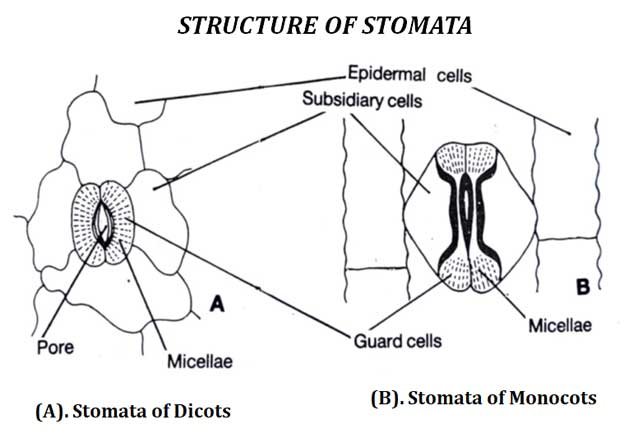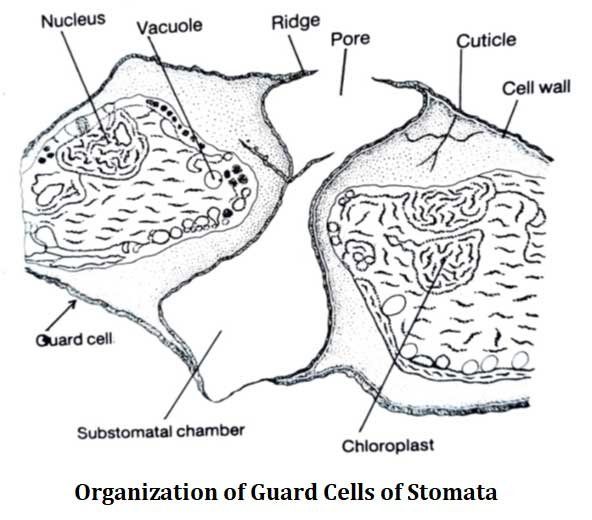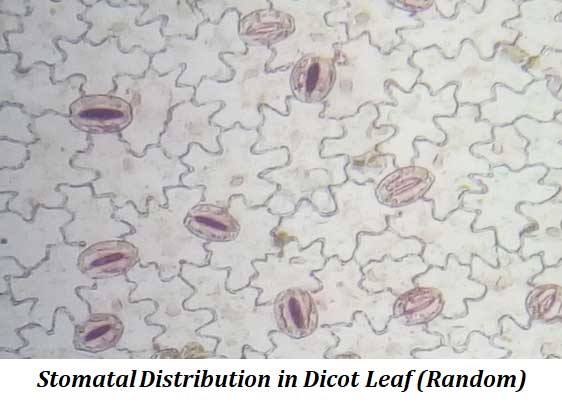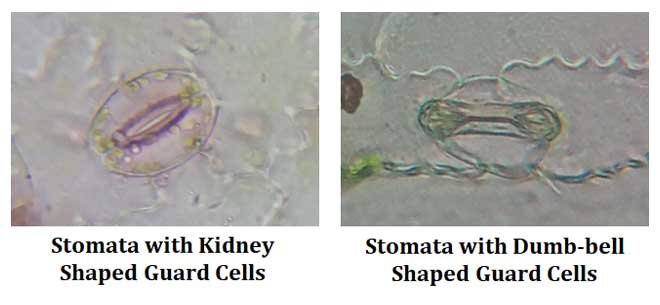Are you curious about the fascinating world of stomata? Stomata are tiny pores found on the leaves and stems of plants, which are responsible for gas exchange and transpiration. However, did you know that not all stomata are created equal? In this article, we will discuss the Structure and Function of Stomata of dicots and monocots.
What are Stomata?
Ø Stomata (singular- Stoma) are tiny openings or pores found on the surface of leaves, stems, and other plant organs.
Ø Stomata allow the exchange of gases, such as carbon dioxide and oxygen, between the plant and its environment and has significant role in transpiration and water absorption.
Learn more: Classification of Stomata
Structure and Function of Stomata
Structure of Stomata
Ø Stoma is surrounded by two specialized epidermal cells called guard cells.
Ø Guard cells are kidney shaped in dicots and dumbbell shaped in grasses.
Ø The wall of the guard cell is unevenly thickened.
Ø The wall surrounding the pore is more thickened and inelastic and impermeable.

Ø Other parts of the wall remain thin, elastic, and permeable.
Ø The radial wall of guard cells has typical fan shaped micellae composed of cellulose.
Ø Micellae enable the guard cells to elongate more than lateral expansion.
Ø Each guard cells have cytoplasm and a large central vacuole filled with cell sap.
Ø The cytoplasm of guard cells contains nucleus and chloroplasts.

Ø Chloroplasts have fewer and ill-organized lamellae than those of mesophyll cells.
Ø The guard cells are also covered with cuticle which extends to the inner forming the boundary of the pore and the substomatal chamber.
Ø Mitochondria, dictyosomes, ER, ribosomes are also found in the guard cells.
Ø The epidermal cells surrounding guard cells are specialised and called subsidiary cells or accessory cells.
Ø The subsidiary cell support in the movement of guard cells.

Ø The size and shape of stomata vary from plant to plant.
Ø Example:
o Phaseolus vulgaris 7 x 3 μ
o Avena sativa 38 x 8 μ
o Zea mays 4 × 26 μ
Ø The number of stomata in a definite area of leaf is called Stomatal Index (SI).
Ø Stomatal index can be calculated by the formula SI = (S/S + E) * 100; where S is number of stomata per unit area and E is number of epidermal cells per unit area.
Ø The stomatal index also varies from plant to plant.
Ø The xerophytes possess larger number of stomata than mesophytes.
Learn more: Xerophytic Adaptations of Plants
Structure of Grass Stomata (Graminoid Stomata)
Ø Grasses (Poaceae) form morphologically distinct stomata.

Ø The grass stomata consist of two dumbbell-shaped guard cells flanked by two lateral subsidiary cells.
Ø Moreover, the stomata in grasses are arranged in parallel rows.
Ø The unique morphology is associated with faster stomatal movements leading to more water-efficient gas exchange in changing environments.
Functions of Stomata
Ø Regulating gas exchange: Stomata allow carbon dioxide to enter the plant for photosynthesis and release oxygen as a by-product.
Ø Regulating water loss: Stomata control the amount of water that escapes from the plant through transpiration. The opening and closing of stomata is regulated by the plant to prevent excessive water loss.
Ø Regulating plant temperature: The opening and closing of stomata help to regulate the temperature of the plant by allowing water to evaporate and cool the plant in hot environments.
Learn more: Unusual Properties of Water
Ø Défense against pathogens: Stomata can help to prevent the entry of pathogens into the plant by closing in response to certain signals from the plant. This helps to prevent infections and diseases from spreading throughout the plant.
Ø Water balance: Stomata also regulate the water balance of the plant by controlling the loss of water vapor through a process called transpiration.
<<< Back to Plant Anatomy Notes
| You may also like... | ||
|---|---|---|
| NOTES | QUESTION BANK | COMPETITIVE EXAMS. |
| PPTs | UNIVERSITY EXAMS | DIFFERENCE BETWEEN.. |
| MCQs | PLUS ONE BIOLOGY | NEWS & JOBS |
| MOCK TESTS | PLUS TWO BIOLOGY | PRACTICAL |
Dear readers
I believe that this article helped you to understand the Structure and Functions of Stomata. I would like to take this opportunity to request your COMMENTS. Whether you have a suggestion, a question about the topic, or simply want to share your thoughts, I would love to hear from you. I appreciate your support and look forward to hearing from you.
Best regards, [Admin, EasyBiologyClass]
